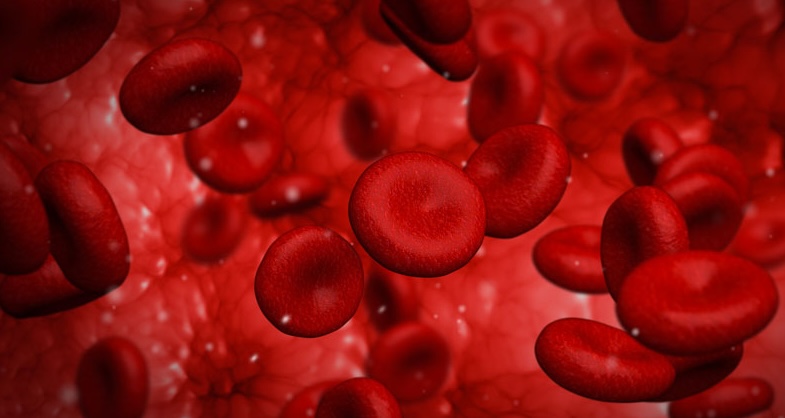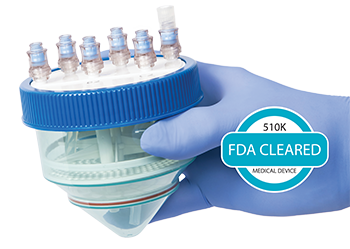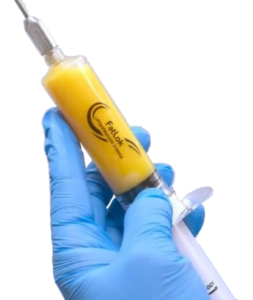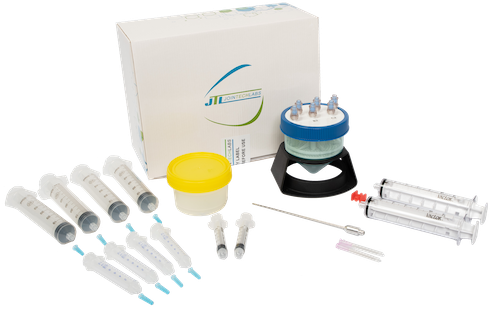Microfat Compared to PRP and BMAC
PRP and BMAC are two orthobiologic solutions that many practitioners use to help patients with OA, injury, and joint pain. Microfragmented adipose tissue (microfat or MFAT) has many advantages over PRP and BMAC in particular conditions and is also successfully used alongside them!
Microfat may be good for your patients and profitable for your practice.

If you use PRP or BMAC in your practice, you know about the pain relieving properties of these two orthobiologics. So when thinking about microfat (MFAT), you may simply ask “why?” Why should I consider another orthobiologic when I am helping my patients with what I already offer? When microfat is compared to PRP and BMAC, MFAT’s advantages become clear.
Briefly, properly-prepared MFAT can be longer-lasting and is truly regenerative compared to PRP, which contains no regenerative cells, or BMAC, which has 1/100th the stem cell content of MFAT. MFAT can also be used for many patients who are contraindicated for PRP or BMAC or who prefer or request microfat. As a bonus, MFAT can often be used together with PRP or BMAC.
Let’s look at some of the benefits of MFAT compared to these orthobiologics.

PRP (Platelet Rich Plasma)
Platelet Rich Plasma has a well documented history of being an effective anti-inflammatory agent when used in patients with joint pain.
PRP obtained by venipuncture and centrifugation addresses symptoms only. When activated, proteins called growth factors contained therein may help reduce the inflammation associated with osteoarthritis and tendinitis, thereby reducing pain and improving function. PRP is not regenerative because it contains no stem cells; it is strictly anti-inflammatory, a symptom-reducing pain reliever.
Microfat Advantages over PRP
- MFAT is a rich source of mesenchymal stem cells (MSCs) and adipose stromal cells (ASCs), while PRP does not contain any regenerative cells and is strictly anti-inflammatory. MSCs and ASCs are considered primary regenerative components to regenerative medicine treatments – i.e. PRP treats symptoms only while microfat promotes healing.
- Stem cells remain numerous in adipose tissue with age so microfat retains potency in older adults.
- Studies have shown that microfat’s anti-inflammatory properties and thus its symptom relief are at least as effective as that of PRP.
- Microfat has cushioning properties that PRP does not.
- More study is needed, but PRP’s length of effectiveness is often weeks to months, while microfat can be up to two years or longer.
- Microfat produced by MiniTC can address up to four joints at the same time for minimal additional expense.
- Some patients feel that removing belly fat, even a small amount, is a very positive bonus.
- A microfat procedure is done in a single visit, in about an hour, whereas PRP can require 3 – 6 visits and 4 – 6 hours total time, as well as multiple blood draws.
- From a patient’s financial perspective, a microfat procedure may have a higher initial cost than PRP, but since microfat’s effectiveness can last longer than PRP, the net cost of microfat treatments can be lower than that of PRP.
- From a physician’s financial perspective, the profit from a single, one-hour microfat procedure can exceed that of a comparable 3 – 6 PRP visits.
When PRP is not Indicated
Some PRP contraindications where MFAT may be appropriate:
- Anticoagulant prescription medications or antiplatelet therapy. In such cases, PRP treatment may need to be delayed for several weeks after the patient stops taking the drugs. If the patient can’t stop the drugs or doesn’t want to wait, MFAT may be used.
- Cigarette smoking. Smoking can lower the platelet count in the blood, while cigarettes contain tar that can hamper the production of growth factors.
- Low platelet count. Smoker or not, the blood must have a platelet count of at least 150/ul.
- Insufficient hemoglobin or low HGB count. The patient must not be anemic, and the blood must have at least 10 g/dl of hemoglobin.
- History of severe liver disease. PRP serum contains platelet-fibrin which forms the basic mesh for tissue healing and is produced in the liver. Insufficient fibrin in the blood can reduce the effectiveness of PRP therapy.
- MFAT may be used in many settings where PRP is not indicated.
BMAC (Bone Marrow Aspirate Concentrate)
BMAC and MFAT have a lot in common in orthopedics. They both can provide pain relief in joints, both are autologous, both less invasive and less costly alternatives to surgery, both are orthobiologic, both have very low risk of infection or rejection, both can often be performed in clinic rather than procedure rooms or hospitals, and both have legions of loyal doctor users and satisfied patients.
They work differently but both contain mesenchymal stem cells (MSCs) that we believe can restore, revitalize, and regenerate injured or damaged tissue.
Microfat (MFAT) has many advantages over Bone Marrow Aspirate Concentrate and can usually be tolerated in cases when BMAC cannot.
Microfat Advantages over BMAC
- MFAT contains many more MSCs and ASCs than does BMAC, and MSCs and ASCs are considered primary regenerative components to regenerative medicine treatments.
- Stem cells remain numerous in adipose tissue with age while MSCs in BMAC significantly diminish after age 50.
- Some patients feel that removing belly fat, even a small amount, is a very positive bonus. Others feel more comfortable losing fat rather than losing bone marrow (even when aware both the fat and the marrow can be replaced).
- Microfat has cushioning properties that BMAC does not.
- MFAT MSCs can be easily harvested and the procedure is less invasive and less painful than the one performed to obtain BMAC. In both cases the quality of the MSCs is highly dependent on the harvesting technique (see MiniTC advantages below).
- In vitro studies demonstrate that MFAT MSCs maintain their phenotype for a longer period and exhibit higher proliferation rates than BMAC.
- Microfat produced by MiniTC can address up to four joints at the same time for minimal additional expense.
Adipose MSCs (ADSCs) vs. Bone Marrow MSCs (BM-MSCs)
| Feature | ADSCs | BM-MSCs |
|---|---|---|
| Abundance | High (~500x more per gram of tissue) | Lower |
| Invasiveness of Harvesting | Minimally invasive (liposuction) | More invasive (bone marrow aspiration) |
| Proliferation Rate | Higher | Slower |
| Differentiation Potential | Strong for fat, bone, and cartilage | Strong for bone, cartilage, and muscle |
| Immunomodulatory Properties | Strong | Strong |
| Clinical Applications | Orthopedics, aesthetics, wound healing | Autoimmune diseases, Orthopedics |
When BMAC is not Indicated, MFAT may be Used:
- For those with systemic diseases such as leukemia and lymphoma after approval by oncologist that disease is in remission.
- On patients using prescription medications that adversely affect bone marrow.
- MFAT is effective in Kellgren and Lawrence (K/L) 4 OA.
- Within 12 weeks of chemotherapy and irradiation.
- Because MFAT is not affected by most prescription drugs.
- For those who have failed BMAC injections.
- If a patient is on a medication that contraindicates BMAC.
- For certain other malignancies or blood borne diseases.
- For patients unable to get off blood thinners for 3-5 days.
- For patients with cerebral palsy or Parkinson’s Disease.
- In almost every setting where BMAC not indicated.
MiniTC Microfat Processing Advantages
MiniTC, the industry-leading microfat processing system from Jointechlabs, has advantages over other MFAT systems. Simply stated, MiniTC is faster, better, and less expensive for reasons including:
- Highest regenerative cell yield. MiniTC produces the industry’s highest cell yield, leading to superior outcomes.
- The standardized protocol eliminates manual shaking and produces consistent results unmatched by other solutions.
- Sterile, disposable, all-in-one: Everything comes in a single box and a sterile, disposable process that simplifies procedures.
- Highest quantity of microfat in one use. Can address up to four joints at the same time for minimal additional expense.
- Quick and consistent results: Pure microfat can be produced in just 10 minutes using the rapid protocol, or 20 minutes using the standard protocol. The entire procedure can take as little as 45 minutes.
- Harvest quality is extremely high based on the patented and acclaimed Harvester Cannula.
- Injectable with a fine gauge needle.
- Fits YOUR workflow. MiniTC can be operated by you or your medical staff right in your office or clinic.
- Simple. At the end of the day, MiniTC stands out because it’s fast and easy to use.
- Competitive price: MiniTC is priced lower than other FDA-cleared alternatives.
- FDA cleared and made by Jointechlabs, an ISO 13485:2016 certified company.
- See more at https://Jointechlabs.com/minitc/



Last Word: Microfat Compared to PRP and BMAC
Many advantages and complementary aspects become clear when microfat is compared to PRP and BMAC.
Physicians who use PRP or BMAC recognize the healing power of orthobiologics. These same physicians owe it to themselves and their patients to consider MFAT and MiniTC.
The information on this page is derived from:
- Scientific Literature & Review Papers:
o Bourin et al. (2013) – The International Society for Cellular Therapy’s position statement on adipose-derived cells (Cytotherapy).
o Pittenger et al. (2019) – Mesenchymal stem cell perspective: cell biology to clinical progress (npj Regenerative Medicine).
o Zuk et al. (2001) – Human adipose tissue is a source of multipotent stem cells (Molecular Biology of the Cell).
o Sensebé et al. (2013) – Comparative analysis of mesenchymal stem cells from different origins (Stem Cells International). - Clinical and Translational Research:
o Studies comparing MSC yield, differentiation potential, and clinical applications between bone marrow and adipose-derived sources.
o Research highlighting that AD-MSCs are more abundant per gram of tissue and proliferate faster, whereas BM-MSCs have stronger osteogenic differentiation. - https://prpinjectionmd.com/prp-injection-contraindications/
- https://www.apcmed.com/services/bone-marrow-aspirate-concentrate-bmac-stem-cell-therapy/
- https://sheinkopmd.com
- Jointechlabs, Inc.